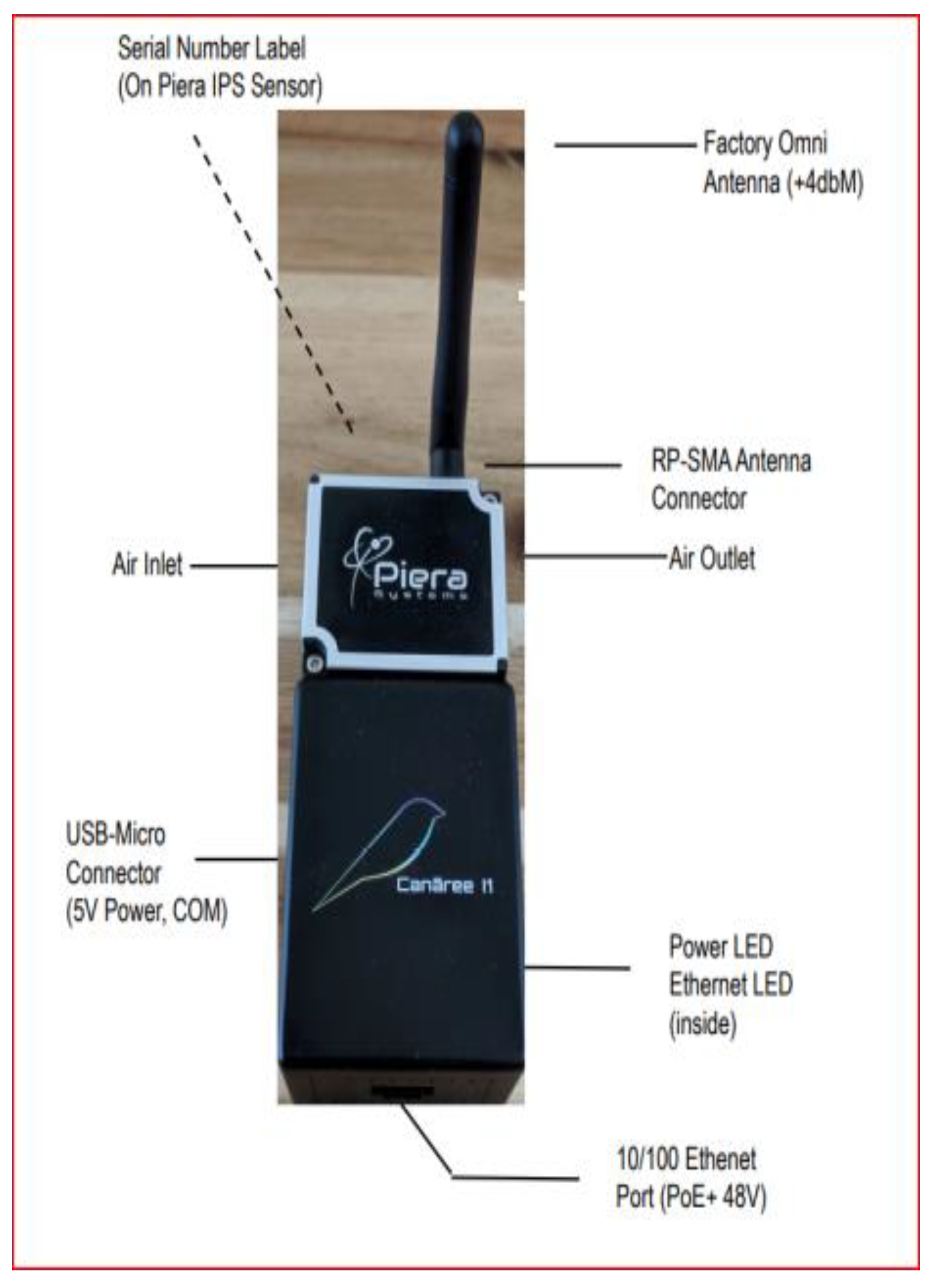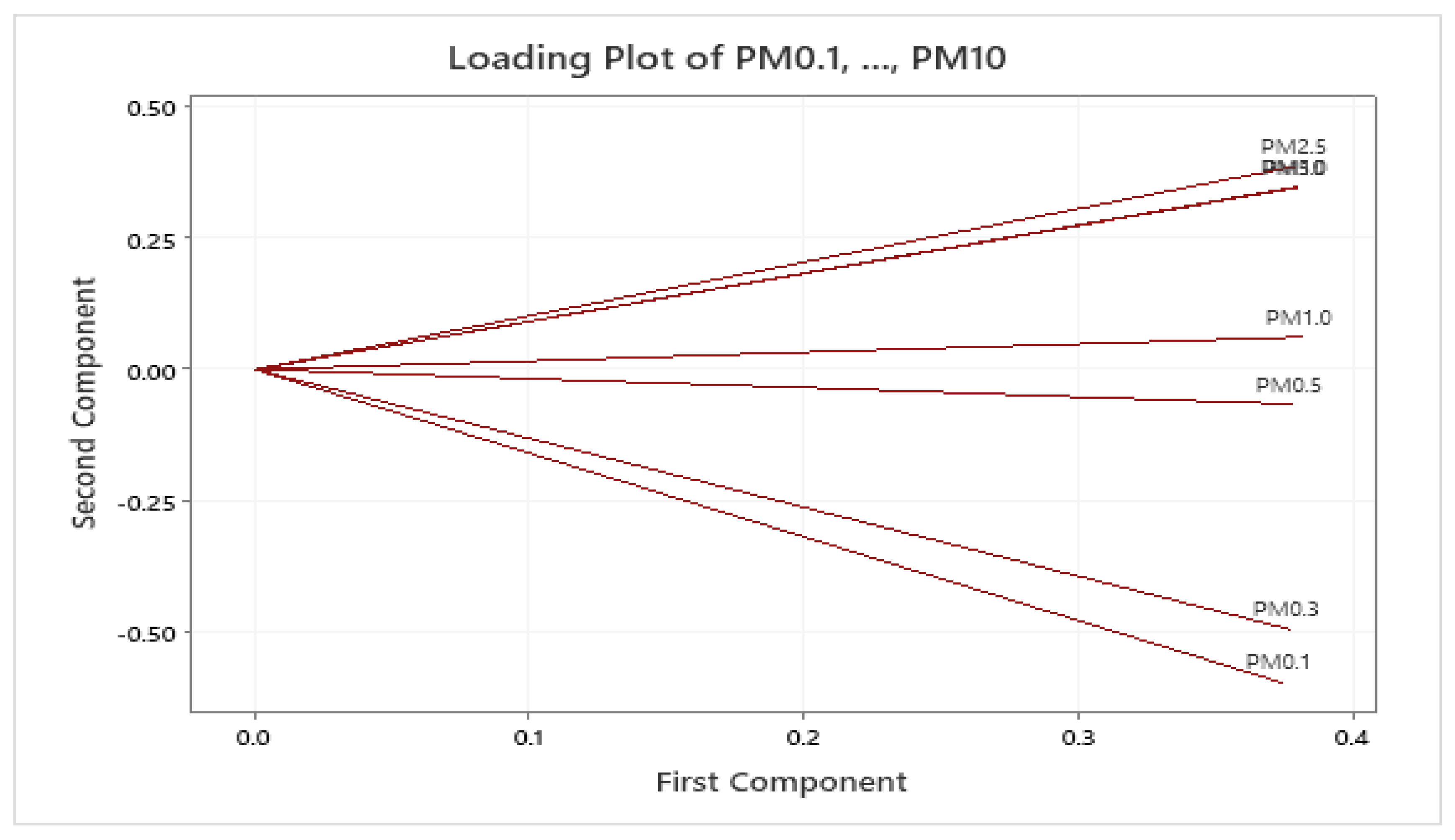Indoor Air Measurements with a Low-Cost Air Quality Sensor: A Preliminary Report †
Abstract
:1. Introduction
2. Materials and Methods
3. Results and Discussion
4. Conclusions
Author Contributions
Funding
Institutional Review Board Statement
Informed Consent Statement
Data Availability Statement
Acknowledgments
Conflicts of Interest
References
- UNSDGs. United Nations Sustainable Development Goals. Department of Economic and Social Affairs Sustainable Development. 2015. Available online: https://www.un.org/goals (accessed on 5 June 2023).
- Zhang, J.; Smith, K.R. Indoor air pollution: A global health concern. Br. Med. Bull. 2003, 68, 9–225. [Google Scholar] [CrossRef] [PubMed]
- Kumar, P.; Hama, S.; Abbass, R.A.; Nogueira, T.; Brand, V.S.; Wu, H.; Abulude, F.O.; Adelodun, A.A.; Anand, P.; Andrade, M.E.; et al. In-kitchen aerosol exposure in twelve cities across the globe. Environ. Int. 2022, 162, 107155. [Google Scholar] [CrossRef] [PubMed]
- Leung, D.Y.C. Outdoor-indoor air pollution in urban environment: Challenges and opportunity. Front. Environ. Sci. 2015, 2, 69. [Google Scholar] [CrossRef]
- Abulude, F.O.; Fagbayide, S.D.; Akinnusotu, A.; Makinde, O.E.; Elisha, J.J. Assessment of the Indoor Air Quality of Akure South—West, Nigeria. Qual. Life 2019, 10, 15–27. [Google Scholar] [CrossRef]
- Abulude, F.O.; Feyisetan, A.O.; Arifalo, K.M.; Akinnusotu, A.; Bello, L.F. Indoor Particulate Matter Assessment in a Northern Nigerian Abattoir and a Residential Building. J. Atm. Sci. Res. 2022, 5, 20–28. [Google Scholar] [CrossRef]
- Piera Systems. SenseiAQ Software Real-Time Air Quality Monitoring for Piera Sensors, Canāree Air Quality Monitors Application User Guide; Version 1.2.2 Updated 10/6/21; Piera Systems Inc.: Mississauga, ON, Canada, 2021. [Google Scholar]
- WHO. What Are the WHO Air Quality Guidelines? Network Updates. Worldwide. 2021. BreatheLife2030. Available online: https://www.who.int/news-room/feature-stories/detail/what-are-the-who-air-quality-guidelines (accessed on 11 February 2022).
- Hair, J.F.; Hult, G.T.M.; Ringle, C.M.; Sarstedt, M. A Primer on Partial Least Squares Structural Equation Modeling (PLS-SEM), 3rd ed.; Sage: Thousand Oaks, CA, USA, 2020. [Google Scholar]
- Tran, V.V.; Park, D.; Lee, Y. Indoor Air Pollution, Related Human Diseases, and Recent Trends in the Control and Improvement of Indoor Air Quality. Int. J. Environ. Res. Public Health 2020, 17, 2927. [Google Scholar] [CrossRef] [PubMed]
- Bujang, M.A.; Sapri, F.E. An application of the runs test to test for randomness of observations obtained from a clinical survey in an ordered population. Malays. J. Med. Sci. 2018, 25, 146–151. [Google Scholar] [CrossRef] [PubMed]



| PM0.1 | PM0.3 | PM0.5 | PM1.0 | PM2.5 | PM5.0 | PM10.0 | |
|---|---|---|---|---|---|---|---|
| p-value | <0.005 | <0.005 | <0.005 | <0.005 | <0.005 | <0.005 | <0.005 |
| A-Square | 1.31 | 1.26 | 1.24 | 1.91 | 2.24 | 2.18 | 2.18 |
| Mean | 0.40 | 6.57 | 41.29 | 133.58 | 460.51 | 557.89 | 559.24 |
| Std | 0.14 | 2.33 | 15.95 | 75.75 | 290.94 | 349.13 | 349.84 |
| Variance | 0.019 | 5.42 | 254.31 | 5738.71 | 84,645.83 | 121,893.85 | 122,388.73 |
| Skewness | 0.31 | 0.33 | 0.41 | 1.01 | 1.29 | 1.27 | 1.27 |
| Kurtosis | −0.98 | −0.90 | −0.24 | 1.51 | 3.11 | 2.96 | 2.96 |
| N | 99 | 99 | 99 | 99 | 99 | 99 | 99 |
| Minimum | 0.18 | 2.87 | 15.88 | 35.47 | 87.13 | 111.85 | 112.14 |
| Q1 | 0.28 | 4.65 | 27.80 | 72.22 | 232.83 | 279.00 | 279.77 |
| Median | 0.38 | 6.21 | 37.98 | 115.01 | 390.15 | 470.84 | 472.13 |
| Maximum | 0.69 | 12.14 | 94.78 | 443.32 | 1796.55 | 2145.91 | 2151.80 |
| Q3 | 0.51 | 8.33 | 54.88 | 181.42 | 685.27 | 783.01 | 785.65 |
| 95% Confidence Interval (mean) | 0.43 | 7.03 | 44.47 | 148.69 | 518.54 | 627.53 | 629.01 |
| 95% Confidence Interval (median) | 0.46 | 7.49 | 45.29 | 150.99 | 478.92 | 579.43 | 581.04 |
| 95% Confidence Interval (Std) | 0.16 | 2.71 | 18.54 | 88.07 | 338.25 | 405.91 | 406.74 |
| Test | ||||||||
| Null hypothesis H0: The order of the data is random | ||||||||
| Alternative hypothesis H1: The order of the data is not random | ||||||||
| Number of Runs | Numbers of Observation | |||||||
| Variable | Observed | Expected | p-Value | Variable | N | K | ≤K | >K |
| PM0.1 | 18 | 50.25 | 0.000 | PM0.1 | 99 | 0.400 | 53 | 46 |
| PM0.3 | 18 | 50.09 | 0.000 | PM0.3 | 99 | 6.566 | 54 | 45 |
| PM0.5 | 18 | 50.37 | 0.000 | PM0.5 | 99 | 41.2.94 | 52 | 47 |
| PM1.0 | 18 | 50.09 | 0.000 | PM1.0 | 99 | 133.576 | 54 | 45 |
| PM2.5 | 18 | 49.65 | 0.000 | PM2.5 | 99 | 460.58 | 56 | 43 |
| PM5.0 | 18 | 49.89 | 0.000 | PM5.0 | 99 | 557.893 | 55 | 44 |
| PM10 | 18 | 49.89 | 0.000 | PM10 | 99 | 559.238 | 55 | 44 |
| K = sample/mean | ||||||||
Disclaimer/Publisher’s Note: The statements, opinions and data contained in all publications are solely those of the individual author(s) and contributor(s) and not of MDPI and/or the editor(s). MDPI and/or the editor(s) disclaim responsibility for any injury to people or property resulting from any ideas, methods, instructions or products referred to in the content. |
© 2023 by the authors. Licensee MDPI, Basel, Switzerland. This article is an open access article distributed under the terms and conditions of the Creative Commons Attribution (CC BY) license (https://creativecommons.org/licenses/by/4.0/).
Share and Cite
Abulude, F.O.; Gbotoso, A.O.; Ademilua, S.O. Indoor Air Measurements with a Low-Cost Air Quality Sensor: A Preliminary Report. Eng. Proc. 2023, 48, 31. https://doi.org/10.3390/CSAC2023-14898
Abulude FO, Gbotoso AO, Ademilua SO. Indoor Air Measurements with a Low-Cost Air Quality Sensor: A Preliminary Report. Engineering Proceedings. 2023; 48(1):31. https://doi.org/10.3390/CSAC2023-14898
Chicago/Turabian StyleAbulude, Francis Olawale, Arinola Oluwatoyin Gbotoso, and Susan Omolade Ademilua. 2023. "Indoor Air Measurements with a Low-Cost Air Quality Sensor: A Preliminary Report" Engineering Proceedings 48, no. 1: 31. https://doi.org/10.3390/CSAC2023-14898
APA StyleAbulude, F. O., Gbotoso, A. O., & Ademilua, S. O. (2023). Indoor Air Measurements with a Low-Cost Air Quality Sensor: A Preliminary Report. Engineering Proceedings, 48(1), 31. https://doi.org/10.3390/CSAC2023-14898






